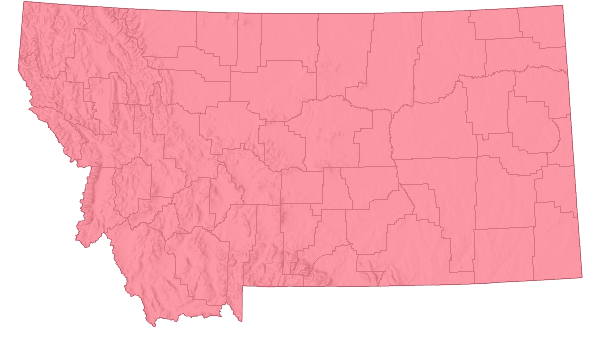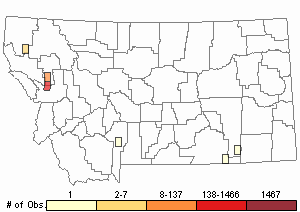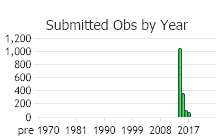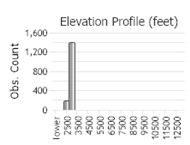View in other NatureServe Network Field Guides
NatureServe
Montana
Utah
Wyoming
Idaho
Wisconsin
British Columbia
South Carolina
Yukon
California
New York
Medusahead - Taeniatherum caput-medusae
Other Names:
Medusa-head
State Rank Reason (see State Rank above)
Taeniatherum caput-medusae is a plant native to Eurasia and introduced worldwide (Miller et al. in Sheley and Petroff 1999). Since 2013 it has been documented at 7 sites in Sanders and Lake Counties of Montana. Medusahead is a serious threat to rangelands, particularly where soils have a high clay content. A conservation status rank is not applicable (SNA) because the plant is an exotic (non-native) in Montana that is not a suitable target for conservation activities.
General Description
PLANTS: An annual grass that grows (2)8 to 20(27) inches tall and can produce tillers. Sources: Miller et al.
in Sheley and Petroff 1999; FNA 2007.
LEAVES: Blades are 0.7-2.5mm wide, flat to rolled. Auricles are usually present, 0.1-0.5 mm long. Sources: Miller et al.
in Sheley and Petroff 1999; FNA 2007.
INFLORESCENCE: Stems typically produce a single spike though large plants may have multiple spikes. A spike typically has 2-3 spikelets per node, but only 1 becomes fertile. Both lemmas and glumes have flat awns. Glumes arise from below the seeds (fruits) at the nodes and remain on the plant after seed dispersal. Glumes are tipped with shorter awns and are 7-80 mm long, erect to reflexed, and have barbs that point upward; they are felt when rubbed in the opposite direction. The long awns attach to the lemmas that hug the seeds; the long awns are 30-100 mm long and remain attached to the seed when dispersed. Sources: Miller et al.
in Sheley and Petroff 1999; FNA 2007.
See
video on Identifying Invasive Annual Grasses in Montana.
Phenology
Grows May to July (FNA 2007).
Diagnostic Characteristics
Taeniatherum caput-medusae (adapted from Miller et al. in Sheley and Petroff 1999): As a seedling leaves appear delicate, slender, and bright green. Developing seedheads are wrapped in leaves with their awn tips visible. As the plant matures the seedhead becomes fully visible and the awns stick straight up. Mature plants are wiry, slender, and have a few short, narrow leaves. As the plant dries it turns from a purplish to tan color, and the awns twist.
Taeniatherum (Medusahead) plants are exotic annuals. Plants have 2-3 sessile spikelets at each node which bear 1 fertile floret and 2 sterile, reduced florets. Lemmas are rounded with few to no scabrous hairs.
Hordeum (Barley) plants are native perennials or annuals or exotic annuals. Plants have 3 spikelets at each node. The central spikelet is sessile while the lateral spikelets have a stalk (pedicel). Each spikelet bears 1 floret. Sometimes there is only 1 fertile floret and 2 sterile, reduced florets. Cultivated plants may differ from this description.
Secale (Cereal Rye) plants are exotic annuals to short-lived perennials. Spikelets mostly 1(2) per node and with 2 florets. Lemmas are strongly keeled and scabrous. Cultivated plants that may occur along roadsides or in fields.
Elymus (Wildrye) plants are native perennials. Spikelets mostly 2-3+ per node, and more than two are fertile. Lemmas are rounded with few to no scabrous hairs. Lemmas are awned. Upper surface of leaf blades may have unequally spaced, prominent veins.
Species Range
Montana Range
Range Descriptions

 Non-native
Non-native
Range Comments
In the western U.S. it occurs along the west coast from Southern California to northern British Columbia and inland to Nevada, Idaho, and Montana (FNA 2007). In the eastern U.S. it has occurred as a rare introduction but does not appear to persist (FNA 2007).
For maps and other distributional information on non-native species see:
Nonindigenous Aquatic Species Database from the U.S. Geological Survey
Invasive Species Habitat Tool (INHABIT) from the U.S. Geological Survey
Invasive Species Compendium from the Centre for Agriculture and Bioscience International (CABI)
EDDMapS Species Information EDDMapS Species Information
Observations in Montana Natural Heritage Program Database
Number of Observations: 1615
(Click on the following maps and charts to see full sized version)
Map Help and Descriptions
Relative Density

Recency



 (Observations spanning multiple months or years are excluded from time charts)
(Observations spanning multiple months or years are excluded from time charts)
Habitat
Plants invade stony soils of disturbed sites in the western states (FNA 2007).
Reproductive Characteristics
LIFE CYCLE
Small silica barbs allow seeds to disperse by clinging to animals, clothing, and machinery. Seeds can also be dispersed by wind, water, and through ingestion and animal droppings.
Depending upon the geographical location germination can initiate in fall, winter, or early spring. Germination occurs in temperatures ranging from 50-60 degrees Fahrenheit (10-15 degrees Celsius). Germination decreases at higher temperatures and seeds can avoid premature germination and wait until cool, wet conditions occur in autumn. Germination can occur faster for Medusahead than for its competitors. Germination has been observed 8 to 10 hours after moistening at low temperatures (50 degrees Fahrenheit or 10 degrees Celsius) and droughty conditions (-11.4 bars). The percentage of viable seeds decreases with time. However, 3-year old seed was found to have more than a 90% germination rate (Nelson and Wilson 1969).
Root growth can occur during the winter even though foliage growth may not be apparent. Root growth in the winter occurs downward while in the spring it occurs laterally. Medusahead roots have been measured as deep as 40 inches (100 cm) (Hironaka 1961). Growth accelerates in the spring and plants mature by late June to early July. Flowers mostly self-pollinate. Maturity often occurs later than most other annual grasses. Seeds can remain in the inflorescence until late summer or early fall.
Management
Stewardship Responsibility
References
- Additional ReferencesLegend:
 View Online Publication
View Online Publication
Do you know of a citation we're missing? Dahal, D., S.P. Boyte, S. Parajuli, N.J. Pastick, M.J. Oimoen, and D. Shrestha. 2022. Early estimates of exotic annual grass (EAG) in the sagebrush biome, USA. U.S. Geological Survey data release, https://doi.org/10.5066/P9FVYOGD.
Dahal, D., S.P. Boyte, S. Parajuli, N.J. Pastick, M.J. Oimoen, and D. Shrestha. 2022. Early estimates of exotic annual grass (EAG) in the sagebrush biome, USA. U.S. Geological Survey data release, https://doi.org/10.5066/P9FVYOGD. Harvey, A.J. 2019. Understanding the biology, ecology, and integrated management of Ventenata dubia. M.Sc. Thesis. Bozeman, MT: Montana State University. 117 p.
Harvey, A.J. 2019. Understanding the biology, ecology, and integrated management of Ventenata dubia. M.Sc. Thesis. Bozeman, MT: Montana State University. 117 p. Lehnhoff, E.A., L.J.Rew, J.M. Mangold, T. Seipel, and D. Ragen.2019. Integrated management of Cheatgrass (Bromus tectorum) with sheep grazing and herbicide. Agronomy 9, 315
Lehnhoff, E.A., L.J.Rew, J.M. Mangold, T. Seipel, and D. Ragen.2019. Integrated management of Cheatgrass (Bromus tectorum) with sheep grazing and herbicide. Agronomy 9, 315 Quire, R.L. 2013. The sagebrush steppe of Montana and southeastern Idaho shows evidence of high native plant diversity, stability, and resistance to the detrimental effects of nonnative plant species. M.Sc. Thesis. Bozeman, MT: Montana State University. 124 p.
Quire, R.L. 2013. The sagebrush steppe of Montana and southeastern Idaho shows evidence of high native plant diversity, stability, and resistance to the detrimental effects of nonnative plant species. M.Sc. Thesis. Bozeman, MT: Montana State University. 124 p.
- Web Search Engines for Articles on "Medusahead"





